‘Today […] men and women […] ride from the first day of spring to the last privileged days of frosty winter. They ride from morning to high noon, and their lanterned wheels purr by with the gleam of a cat’s eye through the dark.’ (The Out Of Door Library: Athletic Sports, 1897)
A couple of years ago I sewed an Edwardian bicycle costume. It consists of a tailored Edwardian brown wool jacket with DIY black fabric soutache, a knee-length blue wool skirt, a refashioned white blouse, black stockings, brown leather boots and an Edwardian staw boater hat trimmed with velvet ribbon.
What Is An Edwardian Bicycle Costume?
In the Edwardian era, it became fashionable to look fit, healthy and toned. That’s why Edwardian women loved sports like cycling, hiking, climbing, rowing, playing golf and fencing.
Related: The Edwardian Sweater Girl + 25 Free Edwardian Sweater Patterns
And Edwardian women had a special outfit for every occasion. For cycling they wore a cycling costume. An Edwardian cycling costume is similar to an Edwardian tailor-made costume made of wool.
Related: Edwardian Shirtwaist Costume: Tailored Wool Skirt & Blouse
‘Short rides on level roads can be accomplished with but slight modification of ordinary attire; and the sailor-hat, shirt-waist, serge-skirt uniform, is as much at home on the bicycle as it is anywhere else the world over.’ (The Out Of Door Library: Athletic Sports, 1897)
Edwardian cycling costume are also similar to Edwardian walking dresses, especially for walks in the rain, consisting of simple, warm clothing and a short wool skirt:
Related: Edwardian Walking Dresses
Parts Of An Edwardian Bicycle Costume
An Edwardian bicycle outfit consisted of a tailored wool jacket and either a wool skirt or wide wool knickerbockers. The skirt was shorter than typical Edwardian skirts: between ankle-length and knee-length.
Related: Short Edwardian Walking Skirt – History Bounding
‘It seems that the favourite costume for country riding will be knickerbockers and gaiters, while the skirt will of course prevail for town wear’ (Tailor-Made Cycling Costume Ad, 1895).
Other parts of an Edwardian cycling costume were stockings, high leather boots or gaiters and a hat.
When To Wear An Edwardian Cycling Costume?
‘The armies of women clerks in Chicago and Washington who go by wheel to business, show that the exercise within bounds need not impair the spick-and-spandy neatness that marks the bread-winning American girl.’ (The Out Of Door Library: Athletic Sports, 1897)
In the Edwardian era, cycling outfits were worn to cycle to work, to take a short bike ride in the city or in the country as recreation after work, or to go on an eco-friendly cycling holiday.
Related: The Edwardian Summer Girl
‘The woman of affairs has learned that an hour, or even half an hour, may be stolen from the working day, with profit to both woman and affairs. […] An hour of the wheel means sixty minutes of fresh air and wholesome exercise, and at least eight miles of change of scene’ (The Out Of Door Library: Athletic Sports, 1897).
Inspirations For My Edwardian Bicycle Outfit
The main inspirations for my Edwardian bicycle outfit were the following antique cycling costumes: 1898 woman’s bicycling ensemble with brown wool jacket with soutache braid, 1896 brown wool cycling suit and 1895 cycling outfit with brown jacket and blue bloomers.
Related: How To Dress In The Edwardian Era
Edwardian Cycling Jacket Pattern
The pattern for the tailored jacket is self-drafted. I adapted my self-drafted basic Victorian bodice pattern: I made it longer and changed the shape of the sleeves. The jacket has princess seams at the back. It also has sloped shoulder seams which is typical of Victorian and Edwardian bodices. The seams that connect the bodice and sleeve are off-the-shoulder which rather makes the jacket a late Victorian cycling outfit.
Short Edwardian Cycling Skirt
‘On the excursion a special adaptation of dress is absolutely necessary; for skirts, while they have not hindered women from climbing to the topmost branches of the higher education, may prove fatal in down-hill coasting; and skirts, unless frankly shortened or discarded, must be fashioned so as to minimize the danger of entanglement with the flying wheel.’ (The Out Of Door Library: Athletic Sports, 1897)
I made two skirts for my Edwardian cycling outfit: a pleated brown wool skirt and a blue wool skirt with two pleats at the front. For the pleated brown wool skirt I refashioned a store-bought skirt that didn’t fit me. And for the blue wool cycling skirt I used a thick, warm and heavy blue wool (or wool blend) fabric from my stash. The blue skirt has two double box pleats at the front.
Wool Fabric & DIY Cotton Velvet Buttons
For the cylcing jacket I used brown wool (or wool blend) fabric from my stash. Because I didn’t have enough of the fabric I added long black cotton velvet cuffs. The expensive black cotton velvet was a small leftover piece that I got from my aunt a few years ago. I also covered buttons with the same black cotton velvet to match the cuffs.
Braided Edwardian Jacket
The front of the cycling jacket and sleeves are braided in military style, like these 1890s military styled ladies’ jackets. Here’s a ca. 1890s black velvet jacket with soutache braid trim, a Victorian black wool riding jacket with soutache and an 1880s red wool coat with black soutache trim.
DIY Fabric Soutache
I made my own fabric soutache braid for the jacket: I cut long strips of thin black lining fabric, joined them together, folded them three times (so that all raw edges are hidden) and stitched down the center to secure the layers. Then I formed loops, pinned the fabric soutache to the jacket and used my sewing machine to stitch it down.
Related: How To Make Fabric Soutache
Edwardian Boater Hat
I wear an Edwardian-style straw boater hat with my Edwardian bicycle costume – similar to this 1899 photograph of a woman in cycling outfit with a boater hat. I trimmed the boater hat with black velvet ribbon to match the velvet on my Edwardian jacket.
Edwardian Bicycle Outfits – Underwear & Accessories
Underneath the cycling jacket I wear my upcycled Victorian-style cotton blouse. I also wear all the necessary Edwardian underwear: a cotton flannel chemise – I wear a chemise made of cotton flannel because it was a cold and foggy winter day – a corset and black cotton stockings. And I wear brown leather boots similar to these 1890s brown leather cycling boots or these 1895-1900 brown leather cycling boots.
Related: Edwardian Unboned Sports Corset
‘I want to suggest that bicycle riding is a most energetic form of exercise, and that one becomes quickly heated by it even on a cool day; therefore, the wearing of underclothing of light flannel, which readily absorbs perspiration, is most important’ (The Book Of Athletics And Out-Of-Door Sports, 1895).
Here’s an 1896 advertisement for a cyclist and athletic corset (in the middle of the page): ‘Perfect freedom combined with […] shape and gracefulness’.
Cycling Better Than Flying!
Writing in 1897, an author who had a ‘mania for flying […] was much impressed a few years ago when some one said to me: “If you want to come as near flying as we are likely to get in this generation, learn to ride a pneumatic bicycle.” […]
A bicycle is better than a horse to ninety-nine men and women out of a hundred, because it costs almost nothing to keep, and it is never tired. It will take one three times as far as a horse in the same number of days or weeks.
In touring with a bicycle I can make fifty miles a day as comfortably as twenty miles on foot; and I can carry all the clothing I need, besides a camera and other traps. The exercise is as invigorating as walking, or more so, with the great advantage that you can get over uninteresting tracts of country twice as fast as on foot. In fact, as any bicyclist knows, walking seems intolerably slow after the wheel’ (The Out Of Door Library: Athletic Sports, 1897).
1890s Bike Novelties: Motor, Aluminum & Bamboo Bikes
I was surprised to read that there were already motor bicycles, aluminum and bamboo bikes in the 1890s! 😀
‘Among the novelties of last winter’s show the greatest interest seemed to be aroused by the motor bicycle, the hill-climbing attachments, the bamboo and aluminum frames, and the tandems. […]
The much-talked-of bamboo and aluminum bicycles may come under the head of attempts to get rid of weight. In the bamboo bicycle, rods of polished bamboo, let into aluminum castings, are used for the frame instead of steel; a steel wire tightened by nuts runs through each rod.[…] one weighing less than nine pounds […] Five years ago the average weight of the road bicycle was from forty to fifty pounds.’ (The Out Of Door Library: Athletic Sports, 1897)
Related: How To Make An Authentic Edwardian Pompadour Hairstyle
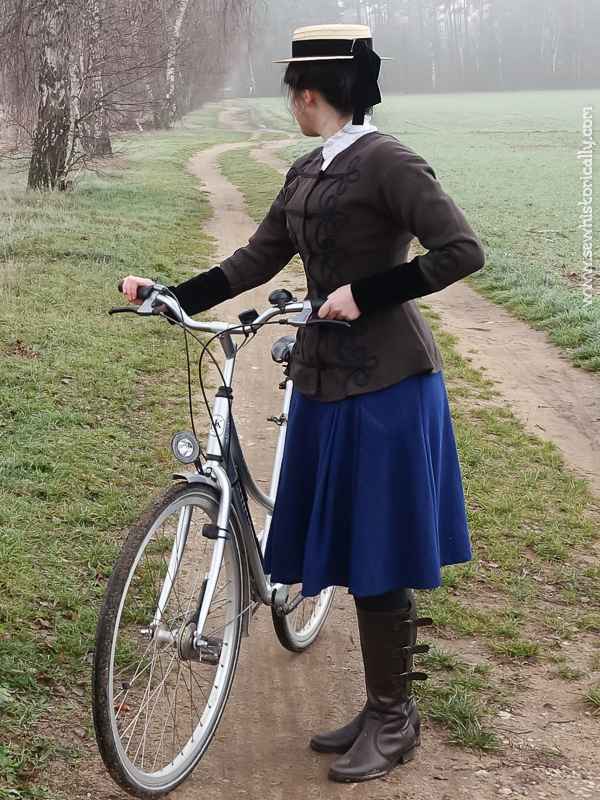
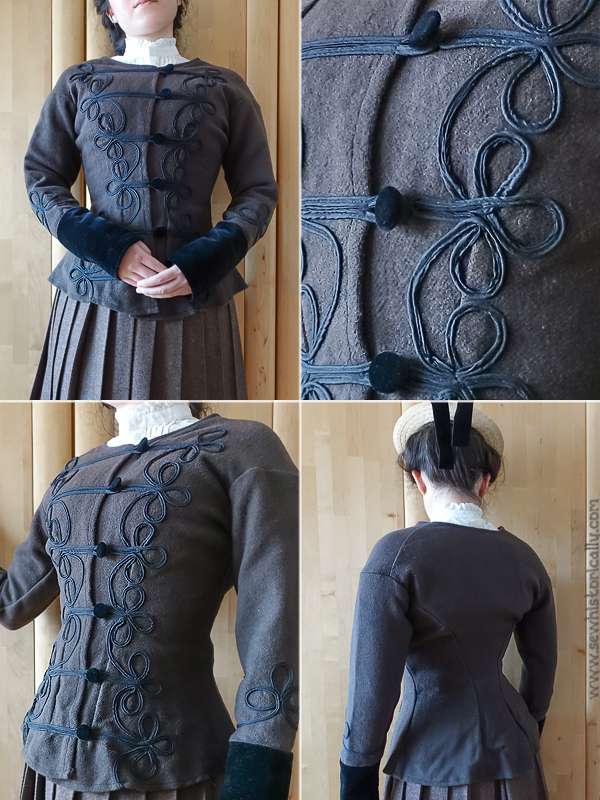
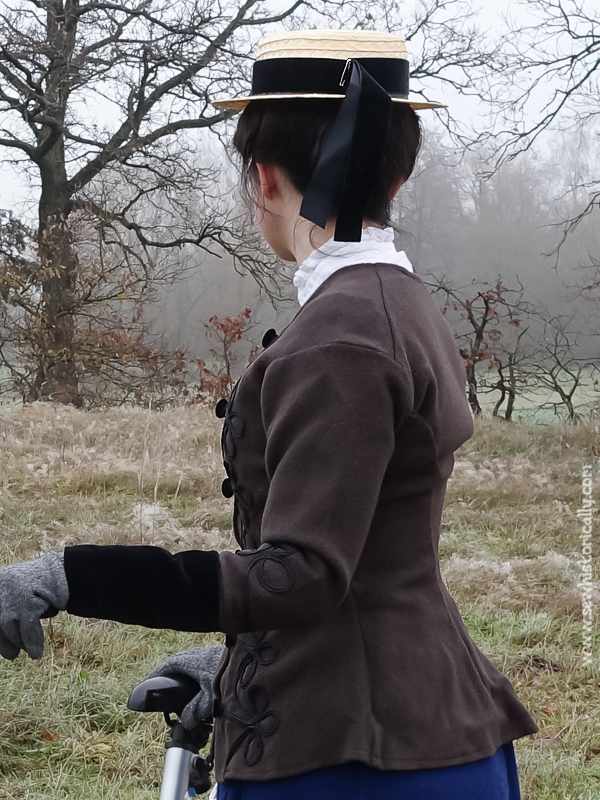
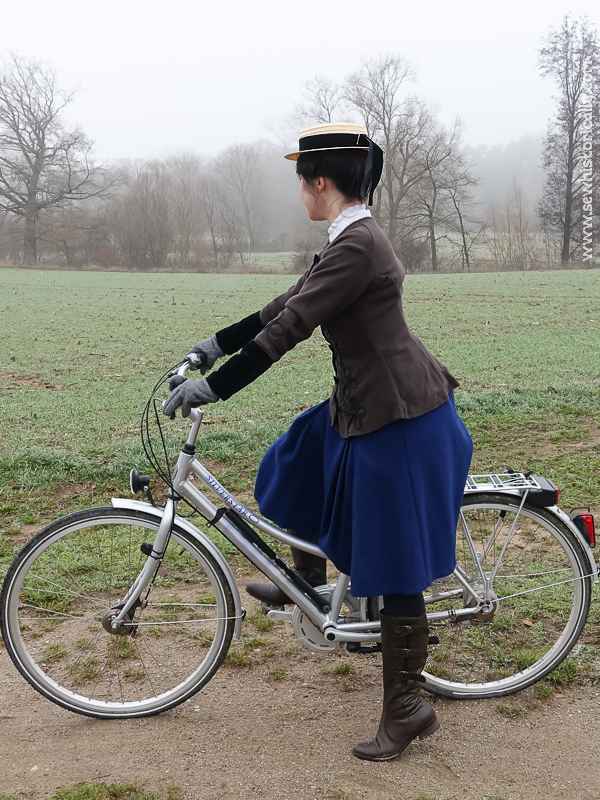
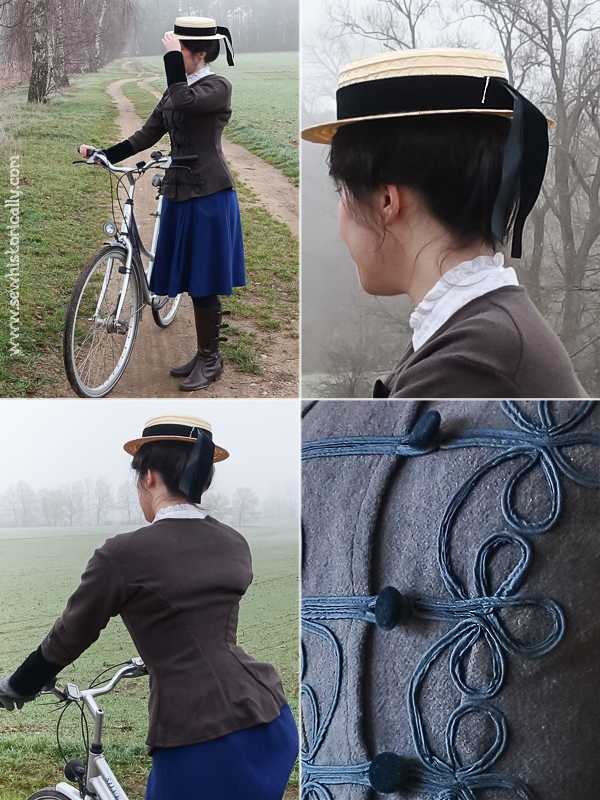
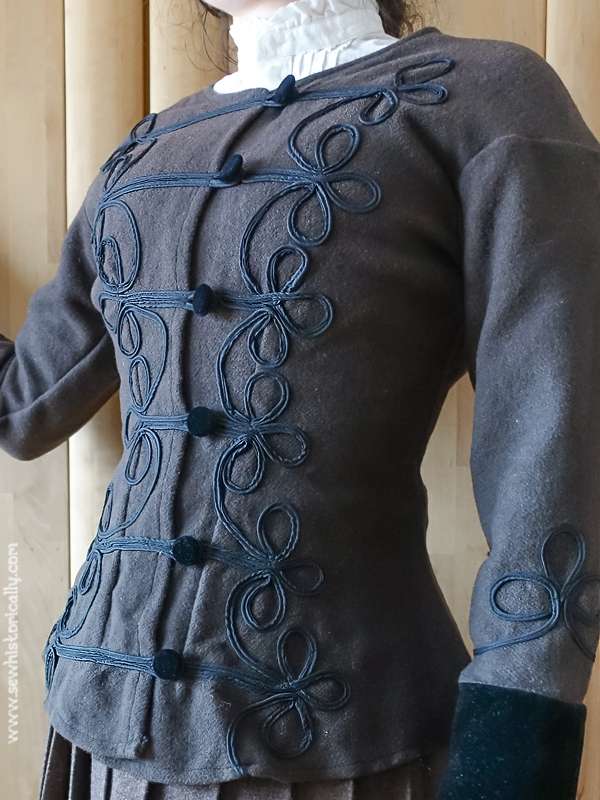
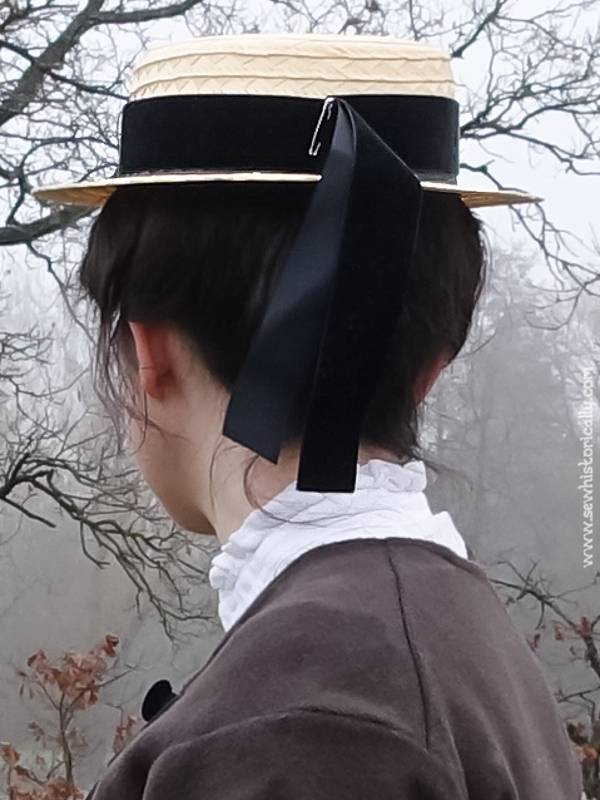
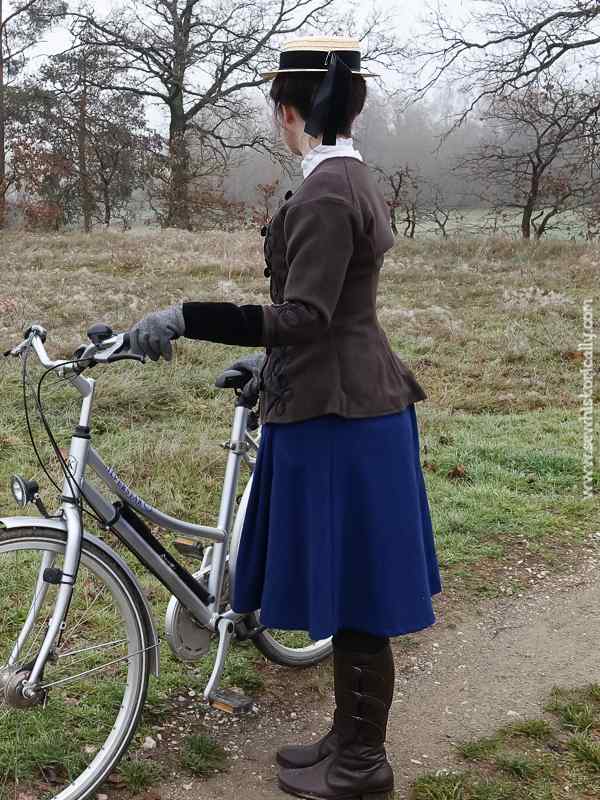
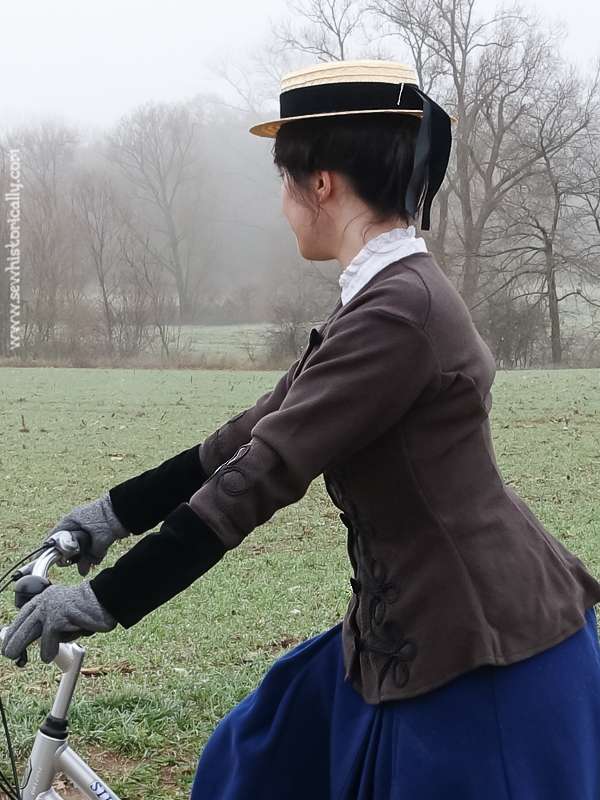
The photos are fascinating, but don’t you get hot wearing all that stuff? Do you have to restrict yourself to cycling on cold days with all that gear?
No, it was actually very cold on that cold November day when we took the photos. No wonder, it was advised in the Edwardian era to wear wool flannel underwear! 😀 My chemise is just cotton flannel, I think wool underwear would be warmer.
What a fantastic job you did on that costume! I love the jacket with all of the trim! Thanks for sharing at Home Sweet Home!
Thank you, Sherry! 😀
What a fantastic job! Found your feature through the Charm of home!
Thanks for stopping by, Angelina! 🙂